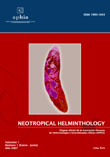PLANT- PARASITIC NEMATODES ASSOCIATED WITH CROP OF TAGETES ERECTA IN VIRU DISTRICT, LA LIBERTAD, PERU
DOI:
https://doi.org/10.24039/rnh2007111148Keywords:
Plant-parasitic nematodes, Meloidogyne, Tagetes erecta, Antagonistic plant.Abstract
The general, frequency and population density of plant-parasitic nematodes associated with Tagetes erecta crops (marigold) in the District of Viru, La Libertad, Peru, were determined. Soil and root samples were collected between March and December 2002, from 14 planted fields. Nematodes were extracted from soil samples by the Christie and Perry’s technique, and from root samples by the modified Baermann’s technique. The roots were also stained for detection of endoparasitic nematodes. Ten genera of plant-parasitic nematodes were found associated with crop of T. erecta in Viru district, which in decreasing order of frequency of fields with each genus extracted from soil were: Criconemoides 85,7 %, Helicotylenchus 78,6 %, Tylenchus 78,6 %, Meloidogyne 71,4 %, Hemicycliophora 64,3 %, Aphelenchoides 57,1 %, Trichodorus 35,7 %, Paratylenchus 28,6 %, Tylenchorhynchus 28,6 % and Pratylenchus 21,4 % and those extracted from roots were: Meloidogyne 64,3 %, Helicotylenchus 42,9 % and Criconemoides 28,6 %. The first three genera showed the highest population densities. Meloidogyne spp. were found inside the tissue of some galls and mostly presented immature forms and null or scarce production of eggs.
Downloads
Published
How to Cite
Issue
Section
License

This work is licensed under a Creative Commons Attribution-NonCommercial-NoDerivatives 4.0 International License.
OBJETO: El AUTOR-CEDENTE transfiere de manera TOTAL Y SIN LIMITACIÓN alguna al CESIONARIO los derechos patrimoniales que le corresponden sobre la (s) obra(s) tituladas: xxxxxxxxxxxxxxxx, por el tiempo que establezca la ley internacional. En virtud de lo anterior, se entiende que el CESIONARIO adquiere el derecho de reproducción en todas sus modalidades, incluso para inclusión audiovisual; el derecho de transformación o adaptación, comunicación pública, traducción, distribución y, en general, cualquier tipo de explotación que de las obras se pueda realizar por cualquier medio conocido o por conocer en el territorio nacional o internacional.
REMUNERACIÓN: La cesión de los derechos patrimoniales de autor que mediante este contrato se hace será a título gratuito.
CONDICIONES Y LEGITIMIDAD DE LOS DERECHOS: El AUTOR-CEDENTE garantiza que es propietario integral de los derechos de explotación de la(s) obra(s) y en consecuencia garantiza que puede contratar y transferir los derechos aquí cedidos sin ningún tipo de limitación por no tener ningún tipo de gravamen, limitación o disposición. En todo caso, responderá por cualquier reclamo que en materia de derecho de autor se pueda presentar, exonerando de cualquier responsabilidad al CESIONARIO.
LICENCIA DE ACCESO ABIERTO: El AUTOR-CEDENTE autoriza que manuscrito publicado en La Revista Neotropical Helminthology permanece disponible para su consulta pública en el sitio web https://www.neotropicalhelminthology.com/ y en los diferentes sistemas de indexación y bases de datos en las que la revista tiene visibilidad, bajo la licencia Creative Commons, en la modalidad Reconocimiento-No comercial- Sin Trabajos derivados –aprobada en Perú, y por lo tanto son de acceso abierto. De ahí que los autores dan, sin derecho a retribución económica, a la Asociación Peruana de Helmintología e Invertebrados Afines (APHIA), los derechos de autor para la edición y reproducción a través de diferentes medios de difusión.

















































